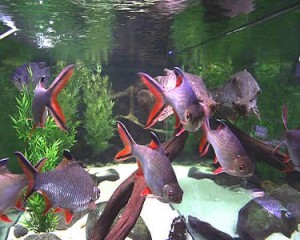| Quick Facts :: Tinfoil Barb | |
| Care Level: | Easy |
| Temperament: | Peaceful |
| Maximum Size: | 14″ |
| Minimum Tank Size: | 70 Gallons |
| Water Conditions: | 74-82° F, KH 4-10, pH 6.0-7.5 |
| Diet: | Omnivore |
| Origin: | Southeast Asia |
| Family: | Cyprinidae |
| Species: | Barbs |
| Aquarium Type: | Community |
 The Tinfoil Barb (Barbonymus schwanenfeldii) originates from the larger rivers and surrounding floodplains of the southeast Asian countries of Vietnam, Thailand, Cambodia and Laos. They live predominately in the larger rivers where they are found in very large schools; however, they will venture off into floodplains during the rainy season and retreat back to the river as flood waters begin to recede. The body shape and swimming style of the Tinfoil Barb is indicative of the flowing waters of their natural river habitat. This species is often mixed in with the smaller Red-tailed Tinfoil barb (Barbonymus altus), which grows to about 10 inches instead of about 14 inches of B. schwanenfeldii. Most hobbyists purchase fish as juveniles which makes it difficult to determine the difference between B. schwanenfeldii and B. altus Tinfoil Barbs, as they cannot use the adult size as a means of comparison. The best way to differentiate juvenile forms of Barbonymus schwanenfeldii and Barbonymus altus is to compare the caudal (tail) fin of the fish. Barbonymus schwanenfeldii possesses a distinct black stripe along each lobe of this fin whereas Barbonymus altus does not. Additionally adult specimens of Barbonymus altus tend to exhibit an overall golden/bronze hue to the body when compared with the more silvery Barbonymus schwanenfeldii.
The Tinfoil Barb (Barbonymus schwanenfeldii) originates from the larger rivers and surrounding floodplains of the southeast Asian countries of Vietnam, Thailand, Cambodia and Laos. They live predominately in the larger rivers where they are found in very large schools; however, they will venture off into floodplains during the rainy season and retreat back to the river as flood waters begin to recede. The body shape and swimming style of the Tinfoil Barb is indicative of the flowing waters of their natural river habitat. This species is often mixed in with the smaller Red-tailed Tinfoil barb (Barbonymus altus), which grows to about 10 inches instead of about 14 inches of B. schwanenfeldii. Most hobbyists purchase fish as juveniles which makes it difficult to determine the difference between B. schwanenfeldii and B. altus Tinfoil Barbs, as they cannot use the adult size as a means of comparison. The best way to differentiate juvenile forms of Barbonymus schwanenfeldii and Barbonymus altus is to compare the caudal (tail) fin of the fish. Barbonymus schwanenfeldii possesses a distinct black stripe along each lobe of this fin whereas Barbonymus altus does not. Additionally adult specimens of Barbonymus altus tend to exhibit an overall golden/bronze hue to the body when compared with the more silvery Barbonymus schwanenfeldii.
Tinfoil Barb live in large schools in nature and generally do not do well when kept singularly or in low numbers in the aquarium. They tend to become more easily frightened and aggressive when not kept in groups. Hobbyists should keep Tinfoil Barb in groups of at least 4 or more individuals in aquariums large enough to support a group of adult fish. While Tinfoil Barbs are not an aggressive species, they are a boisterous species that will swim actively throughout the aquarium. Due to their active nature and aggressive feeding behavior, they may not be suitable for aquariums containing small shy community species. However, they do well with a wide range of tank mates ranging from larger community fish species to semi-aggressive Cichlids and Catfish species. [read more: Aquarium Domain]
